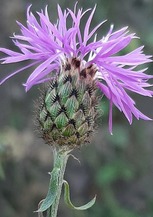|
Noxious Weed Awareness Week
June 2-8, 2024
|
|
Biocontrol of MT State Listed Noxious Weeds
Classical biological control of invasive weeds (biocontrol for short) is the deliberate release of a specialized natural enemy from the weed’s native range to reduce the weeds abundance or spread in its introduced range. Biocontrol is not an appropriate tool for all weeds and/or all sites but can be very beneficial for widespread, abundant weeds.
There are multiple biocontrol agents that have been approved to aid in the management of many of our Montana state listed noxious weeds, however there are four weed/biocontrol systems that are considered to be the most common and effective in our state. These systems are for yellow toadflax, Dalmatian toadflax, leafy spurge, and spotted knapweed.
|
|

Knapweeds - History and Ecology in North America
Knapweeds belong to the genus Centaurea (family Asteraceae), along with starthistles and cornflowers. This genus is native to Europe and Asia, but is particularly species-rich in the Middle East. Centaurea species produce flower heads consisting of a few to several florets subtended by overlapping bracts. Many species have grayishgreen and hairy leaves sometimes deeply divided into irregular lobes.
There are 28 Centaurea species and three hybrids currently present in North America; 21 of these species and the three hybrids are knapweeds. The most troublesome knapweeds in North America are spotted, diffuse, and squarrose. Continue reading...
Learn about Kapweed Biocontrol Agents here.
|
Spotted Knapweed - University of Idaho
What is Spotted Knapweed?
Spotted knapweed is a biennial or short-lived perennial. Its name is derived from the spots formed by black margins on the flower bract tips. Spotted knapweed typically forms a basal rosette of leaves in its first year and flowers in subsequent years. Rosette leaves are approximately 8 inches long by 2 inches wide, borne on short stalks, and deeply lobed once or twice on both sides of the center vein, with lobes oblong and wider toward the tip. The taproot is stout and deep. Flowers are purple to pink, rarely white, with 25 to 35 flowers per head. Plants bloom from June to October, and flower heads usually remain on the plant (Carpinelli 2005).
It is native to Central Europe, east to central Russia, Caucasia, and western Siberia. Spotted knapweed was introduced to North America from Eurasia as a contaminant in alfalfa and possibly clover seed, and through discarded soil used as ship ballast. It was first recorded in Victoria, British Columbia in 1883 and spread further in domestic alfalfa seeds and hay before it was recognized as a serious problem. Today it is widely distributed in Canada and nearly every state in the U.S.
Continue reading...
Click to watch video.
|
|
Classical weed biocontrol: a history and explanation
This video explains the concepts behind classical weed biological control, its history worldwide and in the USA, the safety of this practice, advantages and disadvantages to utilizing this form of weed control, and managing expectations when implementing a weed biological control program.
Click to watch video.
|
|

North American Invasive Species Management Association (NAISMA)
North American Invasive Species Management Association (NAISMA) provides biocontrol resources and supports biological control as an integral part of an Integrated Pest Management (IPM) program. Biological control practitioners from across North America provide technical advice, guidance, and training on IPM, specifically targeting biological control of invasive weeds.
What is biocontrol?
There are many definitions attributed to biological control. For our purposes, we will define the biological control of weeds as the use of live natural enemies (e.g. insects, pathogens, nematodes, mites) of pests to reduce pest population levels below that which would occur in the absence of their natural enemies.
There are commonly three types of biological control recognized:
- Classical – initially small numbers of natural enemies are released in target pest areas for long-term control.
- Augmentative – large numbers of natural enemies are released to control a target pest for a short amount of time.
- Conservation – changing environmental conditions to aid in natural enemy survival.
See NAISMA's Biocontrol Page here.
Register for NAISMA's Biocontrol 101 Course here.
|
|
|
Other Articles and Information |
|
Biocontrol Fact Sheets
The North American Invasive Species Management Association (NAISMA) Classical Biocontrol Committee is excited to announce new peer-reviewed weed biocontrol publications for use by managers and landowners. Subject matter experts are developing a series of factsheets that cover invasive plants and their associated biological control agents in North America. Eighty factsheets for 40 systems will soon be available.
- The weed factsheet covers plant identification, history, distribution, ecology, habitat, and comparisons to look-a-like species.
- The biocontrol agent factsheets provide information on agent identification, life cycle, impact, habitat requirements, history and current status for all biocontrol agents or accidentally introduced species associated with their host plant species.
|
|
|
|